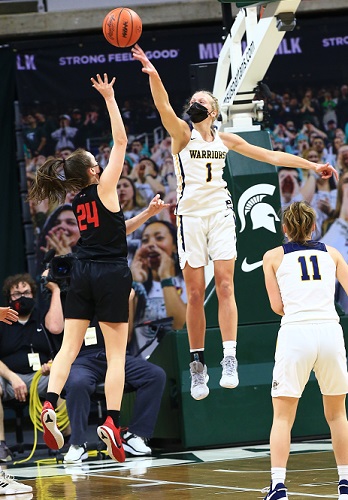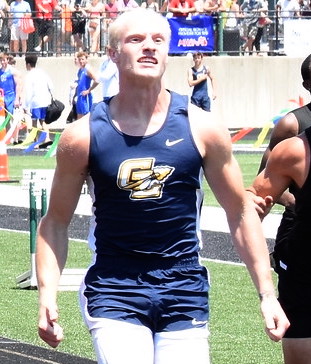
Track Gaining Speed Toward Future with Electronic Starting Devices
By
Steve Vedder
Special for MHSAA.com
May 23, 2023
Aubrey Greenfield thinks it might be the perfect time to reevaluate 130 years of tradition.
For a number of reasons, from technical to personal, the Oxford senior sprinter believes it makes sense for the crack of a starting pistol to be eliminated from high school track meets.
Because track meets would benefit in various ways from lowering costs to easier setup at meets to the human factor of competitors not having to flinch at the crack of a pistol shot, Greenfield believes the sport has a chance to embrace new technology – electronic starting devices (ESD).
In essence, an ESD replaces the starting pistol with a light flash, tone sound or both to begin a race.
"High school sports should put the athlete first," Greenfield said. "We should promote sports, and eliminating starting pistols promotes health in terms of PTSD or trauma for athletes and spectators and that would be good. I would like to think people would say that's a good idea."
In fact, Greenfield would go as far as to say if there was not an implementation of electronic starting devices, many of her teammates would have considered giving up the sport.
"If it's something that helps us compete safely, we're all for it," she said.
Greenfield's opinion apparently is spreading. Michigan High School Athletic Association senior assistant director Cody Inglis said the use of ESD makes it both affordable for meet starters and sensible for athletes and fans to rethink the use of starting pistols. While the MHSAA is not mandating electronic starting devices, it does promote the use of what Inglis calls "emerging technology." He notes that ESD are becoming the norm for organizations such as USA Track & Field, the NCAA and an increasing number of high schools.
 "I think we have to embrace new technology, and we think this will be something that takes hold," Inglis said.
"I think we have to embrace new technology, and we think this will be something that takes hold," Inglis said.
A key part of embracing ESD is the human element. The tragic Oxford High School shooting Nov. 30, 2021, that took the lives of four students while injuring seven others should not be relived even for a fleeting instance at a high school sporting event. Oxford athletic director Tony DeMare said the school began using ESD at every meet, including the MHSAA Lower Peninsula Division 1 Finals last June. He said that decision was embraced by virtually all schools Oxford encountered.
"We were very convinced that the alternative (of ESD) would promote a healthy attitude," DeMare said. "We were overwhelmed with the positive response. If a school was on the fence about it or might not be for it, I think we've started to see the tide turn in favor of people willing to listen and learn about electronic starting devices."
Inglis said the MHSAA is acutely aware of what the crack of a starting pistol can mean to athletes and fans.
"It's unimaginable what Oxford went through, and this is a small way we can help," he said. "We look at a (starting pistol) and think, ‘Could we do something else?’ It's a way of helping to solve a problem."
Over the last several years, the MHSAA has embraced finding an alternative to starting pistols. Inglis noted the discussion started with the cost and diminishing availability of 32-caliber ammunition that meet starters use. A box of ammunition, if it can be found, is around $75 a box.
In addition to cost, there is potential damage from excessive exposure to 150-plus decibels of sound generated by the traditional 32-caliber blanks. Medical studies show damage to ears caused by decibel levels above 120 dB.
The tragedy at Oxford accelerated the conversation.
Inglis said the cost of ESD can be likened to a school sinking money into artificial surfaces at football fields. Yes, there is a great cost at first, but over time money is ultimately saved. An ESD system itself ranges between $200 and $500. Speakers also may need to be purchased, but with ESD starting events like the 800 and 1,600-meter relays positioned near the outside lanes 8, 7, 6 and 5 would result in improved hearing by athletes at the start of a race.
There is one challenge with ESD that track administrators are working to overcome – lighting conditions that lessen the ability to see the ESD’s LED light or strobe when the button is pressed by a starter to begin a race. But that vision difficulty resulting from clear blue skies and backgrounds of setting suns can be substantially improved by incorporating a black background with an ESD – something as simple as a starter holding up black cardboard behind the lighting mechanism at the start of an event.
Inglis said when all factors are considered, the use of ESD makes sense.
 "With the climate we live in nowadays, no lookalike guns is good," he said. "We're not mandating this. But people are saying this is affordable."
"With the climate we live in nowadays, no lookalike guns is good," he said. "We're not mandating this. But people are saying this is affordable."
While switching to ESD would break 130 years of tradition, the timing could be a step forward, said Jeff Hollobaugh, co-author of the book "The Fleet Feet of Spring: Michigan's High School State Championships in Track & Field." He said while no definitive answer is possible, it's likely starting pistols were used at the inaugural state meet at the Jackson Fairgounds in 1895. The meet, which included events like tossing a 16-pound shot put, bike races and a 100-meter sprint, was sponsored by the Michigan Interscholastic Athletic Association (a predecessor to the MHSAA) and comprised mostly of the state's larger schools.
Hollobaugh's sentiments echo what many involved in today's high school track & field believe in terms of making a transition from starting pistols to electronic starting devices.
"It's a change, not necessarily good or bad, just different," he said. "It's not a drastic change, but it will take some getting used to. But it is the future. In the end, we'll all be fine."
DeMare believes the future of high school track will definitely include ESD.
"Our desire is that the practicality and sensibility of this will overcome the alternative," he said. "I think we'll see the automation and electronics taking hold of certain elements in track, and people will embrace it."
PHOTOS (Top) Runners watch official Bertha Smiley as they prepare to begin a race during last season's Lower Peninsula Division 1 Finals at Rockford. (Middle) An electronic starting device provided by VS Athletics was used to start those races. (Below) Smiley sets to begin an event. (Photos provided by David Kuderka/VS Athletics.)

Senior Standout Aiming to Add to Grass Lake & Family Fame
By
Doug Donnelly
Special for MHSAA.com
August 17, 2021
GRASS LAKE – What will Lexus Bargesser do for an encore?
 The Grass Lake senior had an unbelievable junior year, leading the Warriors to their first-ever MHSAA Finals basketball championship, in Division 3, then winning three events to pace Grass Lake’s team title at the Lower Peninsula Division 3 track & field championship meet. She spent her summer on the basketball circuit, traveling the country to compete against top competition.
The Grass Lake senior had an unbelievable junior year, leading the Warriors to their first-ever MHSAA Finals basketball championship, in Division 3, then winning three events to pace Grass Lake’s team title at the Lower Peninsula Division 3 track & field championship meet. She spent her summer on the basketball circuit, traveling the country to compete against top competition.
As she embarks on her senior year of high school, Bargesser is looking forward to having fun, working hard – and bringing home more hardware.
“It was pretty amazing,” she said this summer. “Everything came together and worked out.”
The Bargesser family certainly could have been called the first family of Grass Lake sports over the last few years – in the least for track & field – and Lexus is likely to add a few more highlights during 2021-22. She won’t play a sport for Grass Lake this fall as she’s prepping for basketball season and a hopeful encore to last winter’s achievement. But next month she will begin making college visits and could make a decision before the 2021-22 basketball season begins.
“I don’t really have a timeline,” she said. “I’m looking forward to the season and helping the younger girls on the team grow. I’m excited for it.”
Grass Lake’s Bargesser surge began with 2020 grad Xavier, who’s currently playing basketball at Alma College.
Second-oldest Brennen Bargesser made a splash last school year as a senior both on the basketball court and track, during the spring winning three individual events and running on a first-place relay to lead the boys team to a Finals title as well.
 “My older brother and my younger sister are insane athletes,” Brennen said. “I’m the middle child and just wanted to make a name for myself.”
“My older brother and my younger sister are insane athletes,” Brennen said. “I’m the middle child and just wanted to make a name for myself.”
Lexus Bargesser had won the 100 and 200 dashes as a freshman at the 2019 Finals, then burst onto the national prep basketball scene with an amazing summer that saw colleges from across the country start offering her scholarships.
Their parents also are part of the mix. Father David Bargesser coached the Warriors boys basketball team last season and was an assistant to the girls team. Mother Lori Bargesser was the scorekeeper for the boys team.
Sports is the common bond that links the entire family.
“We’re a really close family,” Lori said. “We’ve always just played sports. That’s what we did. We were in the yard from the time I can remember.”
David, who played basketball and golfed in college, and Lori are from upstate New York. They originally moved to Belleville, then landed in Jackson when he accepted a job at the Michigan Department of Corrections. The family has lived in Grass Lake for about 25 years.
“When I got off work, we’d go outside and play basketball or throw the football,” he said. “From the time I can remember, we were always outside playing something.”
Lori said the organized sports started through a local YMCA.
“Xavier was probably 3 or 4 years old,” she said. “David helped coach. Ever since they started, they were always in at least two sports. It was hectic at times, with practice schedules and everything. It was weird when one of them could drive because they could take themselves to practice.”
Xavier, being the oldest, was the first to play organized sports. Brennen soon followed.
“Basketball is very important in my family,” Brennen said.
“As soon as they could walk, they had a basketball in their hands,” Lori said.
 Lexus showed her basketball talent and poise from a young age.
Lexus showed her basketball talent and poise from a young age.
“Basketball was the thing that took off for her,” her father said. “I remember realizing how fast she was on the basketball court. I didn’t realize how fast she was.”
One of the first colleges to offer was UCLA.
“Once one started offering, they all took notice,” David said. “It was a fun two weeks where everyone started calling. She’s would get 4-5 calls in an hour and a half.”
The Bargessers might have had the best day for any one family in state track & field history. Along with both Grass Lake teams winning championships, Brennen won the 100 with a time of 11 seconds, the 200 in 22.6 and the 400 in 49.10. He also anchored the 400 relay that came in first with a time of 44.43.
Lexus repeated as LPD3 champ in both the 100 with a time of 12.12 and the 200 in 25.30. (She had won both in 2019, and the 2020 season was canceled due to COVID-19.) She set an LP Division 3 meet record with a time of 55.54 in the 400, then helped the 400 relay place second with a time of 4:11.54.
Between the two siblings were seven first places, one runner-up finish and two team championships.
“When Brennen won that first race, I was so happy for him,” Lori said. “He had worked so hard. Lexus had won before, but he never had. That was a great moment.”
The seeds of those championships were formed during the spring of 2020 when in place of their season Brennen and Lexus trained together almost every day.
“It’s insane to think (about) what we were able to accomplish,” Brennen said. “She’d run the 100 and win it, then I’d run the 100 and win it. I got so excited for her, then I had to run my race. In the conference meet I jumped (early) and was disqualified. I was nervous at the state meet that I would do that again.”
Lexus and Brennen have always been close. Training together brought them closer.
“We spent all summer running together,” Brennen said. “She was my pacer. She was helping me get my times in.”
Their dad was confident that both could accomplish what they set out to do at this spring’s Finals because he had watched their times closely all summer.
“Going into the year, I was checking times and seeing what other kids were doing,” David said. “I knew both had a chance to do it in all three events. It was definitely the goal. It helped them by training together. Brennen really was into lifting, and I think that helped Lexi get into it. The two of them were always training together, pushing each other.”
 Doug Donnelly has served as a sports and news reporter and city editor over 25 years, writing for the Daily Chief-Union in Upper Sandusky, Ohio from 1992-1995, the Monroe Evening News from 1995-2012 and the Adrian Daily Telegram since 2013. He's also written a book on high school basketball in Monroe County and compiles record books for various schools in southeast Michigan. E-mail him at [email protected] with story ideas for Jackson, Washtenaw, Hillsdale, Lenawee and Monroe counties.
Doug Donnelly has served as a sports and news reporter and city editor over 25 years, writing for the Daily Chief-Union in Upper Sandusky, Ohio from 1992-1995, the Monroe Evening News from 1995-2012 and the Adrian Daily Telegram since 2013. He's also written a book on high school basketball in Monroe County and compiles record books for various schools in southeast Michigan. E-mail him at [email protected] with story ideas for Jackson, Washtenaw, Hillsdale, Lenawee and Monroe counties.
PHOTOS: (Top) The Bargesser family celebrated a championship-loaded Lower Peninsula Division 3 Finals; pictured from left: father David, Brennan, Xavier, Lexus and mother Lori. (Middle) Lexus Bargesser (1) gets a hand up on defense during Grass Lake’s 52-50 win over Kent City in April’s Division 3 Final. She finished with 16 points, 10 rebounds and five steals. (Below) Brennen Bargesser crosses the line first in the 100 at the Finals in June. (Top photo courtesy of the Bargesser family; Brennen Bargesser photo by Jason Ruggles.)

